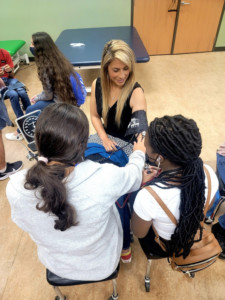Why Didn’t Early College Catch Fire?

Ten years ago tomorrow Utah Gov Mike Leavitt and I sat down to breakfast with a small group of reporters to brief them on a plan for a network of six early college high schools. The briefing was cut short when the governor’s chief of staff whispered in his ear that airplanes had crashed into the World Trade Center. A dozen of us huddled silently around a six inch TV in the kitchen of the governor’s mansion. A brazen reporter interrupted the horror and asked the governor, “What does this mean for the Olympics?”
I ended up having an unexpectedly long stay in the governor’s mansion (picture) and the Leavitt/Romney games went off without incident (other than long lines). A lot has changed in ten years, but there are less than 250 early college high schools—a unique opportunity for students to earn college credit up to a full Associate Degree along with their high school diploma.
Leavitt was a visionary governor. Competency-based Western Governor’s University was his idea. He made one of the three phone calls that led to the creation of the Early College High School Initiative (Cece Cunningham, Middle College Consortium, and Leon Botstein, Bard College, were the other two). Leavitt knew many students would respond to the challenge and opportunity to move faster and gain two years of free college credit.
Over the last decade, opportunities have expanded for high school students to earn college credit. Advanced Placement and International Baccalaureate courses and their accompanying tests give many students ways to take college-level courses from their regular teachers, usually during their senior year. In contrast, students in dual enrollment programs remain formally enrolled in high school but take college courses, taught by either high school or college faculty, in classrooms located either at their high school or on a college campus. At the same time, more and more community colleges are developing ways to accelerate high school students (as well as high school dropouts) by enrolling them in college courses. Meanwhile, a variety of postsecondary incentive programs reward students with free or reduced college tuition for finishing some college work in high school. And, at the most dramatic end of the continuum, students at middle colleges and early college high schools can complete up to two years of a college program while still enrolled in high school.
Until recently, this educational terrain of college-courses-in-high-school belonged almost exclusively to a small, privileged group of young people: those whose families could afford high-quality private high schools and those in well-funded public schools that offered Advanced Placement and similar options to their highest-achieving students. But today’s programs that allow students to earn college credit in high school are no longer limited to elite schools. Students from a wide range of backgrounds and with diverse prior accomplishments are demonstrating that the academic challenge provided by college-level courses can be an inspiration, not a barrier. The job of early college high school faculty and partners is to refine the instructional practices and wraparound support structures that move students from inspiration to true achievement. Some of the most promising strategies currently in use in early college high schools include: adopting school-wide literacy practices, focusing on inquiry-based instruction across grade levels and content areas, and creating “shadow” or “lab” courses to complement college courses. The question for the future is the degree to which opportunities like these will increase the number of young people who gain a postsecondary credential—especially among those who remain underrepresented in higher education.
AP and IB programs continue to grow steadily. Early college is an even better deal. So, if this is such a great idea why aren’t there 2500 early colleges? It’s really hard and time consuming to work across the post secondary boundary. Colleges don’t like giving up lower division tuition; high schools don’t like sharing ADA revenue with colleges. And almost every early college is a custom bargain; concurrent enrollment policies are different in every state.
In short, it comes down to money and bureaucracy. Boundary breaking innovations like early college take a champion like Leavitt. Fortunately, the rapid growth rate of online learning in both secondary and post-secondary will facilitate new blends.
For more see:
- Transitions: Hilary Pennington ran Jobs for the Future which served as the intermediary for ECHSI
- AEE Releases Promising Practices (including dual enrollment)
- WGU Growing by 30% (and many other Getting Smart posts referencing WGU)






0 Comments
Leave a Comment
Your email address will not be published. All fields are required.